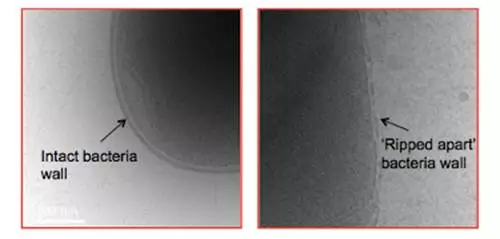|
工作时间 周一至周五 :8:30-17:30 周六至周日 :9:00-17:00 联系方式 电话:0574-87681087 邮箱:rotic@crystalgenchina.com 地址:宁波市高新区江南路1558 浙大科技园7001室 网址:www.crystalgenchina.com 美国公司:25 AUSTIN BLVD,COMMACK,NY 11725 UNITED STATES |
耐药超级细菌不再无敌 : 撕裂细胞壁的超级药 | Nature Microbiology 论文推荐 二维码
541
超级细菌已经成为21世纪对人类健康最大的威胁之一,最近,墨尔本的科学家研发的星形蛋白质分子链“结构性纳米抗菌聚合肽” (SNAPP)在对抗耐抗生素的超级细菌方面取得了重大突破。SNAPP 通过“撕裂”细菌细胞壁杀死细菌,并毒性较低,进一步深入研究后有望应用于临床中。 来源 The manufacturer 撰文 Aiden Burgess 翻译 雷文茜 审校 刘小鸥
正在观察细菌培养基的研究者。图片来源:themanufacturer 世界卫生组织指出,能够对大多数形式的抗生素产生耐受性的超级细菌已经成为严重威胁人类健康的杀手。这种耐抗生素超级细菌每年剥夺数百万人的生命。最近,墨尔本大学工程学院的研究团队研究出一种名为“结构性纳米抗菌聚合肽”(SNAPP)的全新的星形蛋白质分子链,可以有效杀死耐抗生素的细菌。相关研究发表于 Nature Microbiology。
研究表明这种聚合肽可以对所有革兰氏阴性菌,包括 ESKAPE(即肠球菌、金黄葡萄球菌、克雷伯氏菌、不动杆菌属、假单胞菌属与肠杆菌生物)和耐粘菌素以及 MDR (CMDR,即多重耐药)致病菌表现出亚微米级活性,同时具有较低的细胞毒性。
综合实验分析表明,SNAPP 的抗菌活性主要以细菌细胞的多模式死亡机制进行,涉及细菌细胞外膜失稳、离子跨细胞质膜运动失调和类凋亡的死亡通路的激活。研究者认为这些机制可能就是 CMDR 细菌没有对 SNAPP 产生耐受性的原因。
左:完整细菌细胞壁 右:被星形肽聚合物“撕裂”的细胞壁。图片来源:墨尔本大学 蛋白质分子“撕裂”耐抗生素细菌 这种被叫做聚合肽的星形蛋白质分子链通过“撕裂”超级细菌细胞壁的方式杀死它们。 研究者说,正是因为细菌很难适应聚合肽这种“撕裂”细胞壁的方式,所以实验中没有发现细菌对聚合肽产生耐受性,这是聚合肽优于抗生素之处。
在探索究竟哪种分子可以突破耐抗生素超级细菌的壁垒的过程中,研究者对六种不同的超级细菌进行了体外测试,最后发现星形聚合肽可以达到这个目标,并且在体外环境中没有对血红细胞产生伤害。
研究者也在小鼠体内测试了这种聚合物对一种超级细菌的功效,结果证明聚合肽在实验中对这种特定的细菌也有效。
不过,研究者认为这项工作仍然处于初级阶段,目前只针对一类主要的细菌。未来的研究将会探索其他细菌对这种蛋白质分子的反应。
文章来源 http://www.themanufacturer.com/articles/melbourne-scientists-make-breakthrough-against-antibiotic-resistant-superbugs/ 论文基本信息 【题目】Combatingmultidrug-resistant Gram-negative bacteria with structurally nanoengineeredantimicrobial peptide polymers【作者】Shu J. Lam. et al. 【刊期】Nature Microbiology 【日期】12. Sep. 2016 【DOI】10.1038/nmicrobiol.2016.162 【摘要】With the recent emergenceof reports on resistant Gram-negative ‘superbugs’, infections caused bymultidrug-resistant (MDR) Gram-negative bacteria have been named as one of themost urgent global health threats due to the lack of effective and biocompatibledrugs. Here, we show that a class of antimicrobial agents, termed ‘structurallynanoengineered antimicrobial peptide polymers’ (SNAPPs) exhibit sub-μM activityagainst all Gram-negative bacteria tested, including ESKAPE andcolistin-resistant and MDR (CMDR) pathogens, while demonstrating low toxicity.SNAPPs are highly effective in combating CMDR Acinetobacter baumanniiinfections in vivo, the first example of a synthetic antimicrobial polymer withCMDR Gram-negative pathogen efficacy. Furthermore, we did not observe anyresistance acquisition by A. baumannii (including the CMDR strain) to SNAPPs.Comprehensive analyses using a range of microscopy and (bio)assay techniquesrevealed that the antimicrobial activity of SNAPPs proceeds via a multimodalmechanism of bacterial cell death by outer membrane destabilization,unregulated ion movement across the cytoplasmic membrane and induction of theapoptotic-like death pathway, possibly accounting for why we did not observeresistance to SNAPPs in CMDR bacteria. Overall, SNAPPs show great promise aslow-cost and effective antimicrobial agents and may represent a weapon incombating the growing threat of MDR Gram-negative bacteria. 【原文链接】http://www.nature.com/articles/nmicrobiol2016162 这与我公司产品“超级消毒液"的作用机理很相似,在北美医院和试验室很受欢迎,证明了我们的设计理念是很超前的。
文章分类:
行业新闻
|


